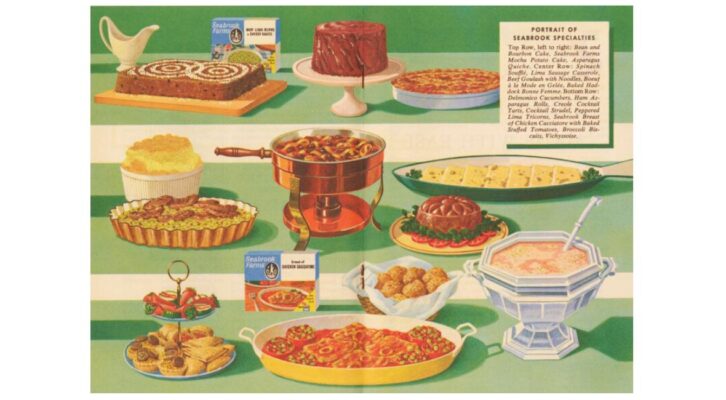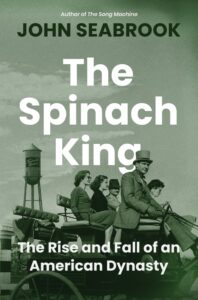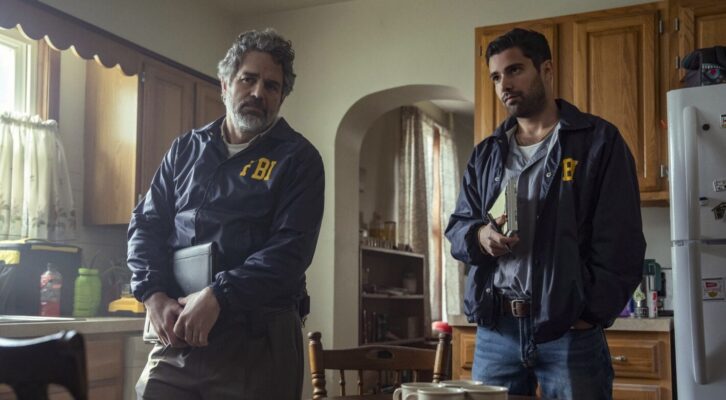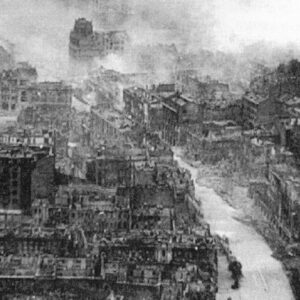
Decline and Fall of the Spinach Kings: On the Wilting of a Family Dynasty
John Seabrook Explores a History of Wealth, Enterprise, and Family Dysfunction
My London-born great-grandfather, Arthur P. Seabrook, emigrated to the United States at the age of five. He arrived with his family at the Battery, on the southern tip of Manhattan, in January 1859. Over the next three generations, Arthur’s fifty-eight acres of vegetable and produce fields in southern New Jersey became the largest farm in state history. At its peak, in the mid-1950s, Seabrook Farms owned or controlled fifty thousand acres in the southwestern corner of the Garden State, employed up to eight thousand people or more at one time, and grew and packed about a third of the nation’s frozen vegetables. As a model of agricultural engineering, there were few farms in the world that compared. Asparagus could be cut, trucked to the plant, trimmed, washed, blanched, packaged, and quick-frozen to -40 degrees Fahrenheit in less than two hours; one was the goal. A 4-page photo essay that Life magazine published in January 1955 called Seabrook Farms, with only some hyperbole, “the biggest vegetable factory on earth.”
The Seabrook Farms brand stood for family, freshness, and domestic modernity. Its advertising promised an end to drudgery through food engineering. As a 1959 Seabrook print ad blared “Food Miracle Frees Wife…Delights Husband!” Seabrook Farms Frozen Creamed Spinach, sold in the boil-in-the-bag Mylar Miracle-Pack, became the brand’s signature product, known and sought after up and down the East Coast. Seabrook’s cutting-edge packaging materials lent a space-age feel to its wares. In Stanley Kubrick’s 1968 film 2001: A Space Odyssey, Floyd, one of the astronauts, is briefly glimpsed sucking from a meal of Seabrook Farms Liquipacks—a liquified carrot, fish, and leafy vegetable—while transiting to the moon.
*
Charles Franklin Seabrook, my grandfather, was the principal dreamer, main promoter, political fixer, master builder, and autocratic ruler of this industrial farming empire—and ultimately its destroyer. The original vegetable factory was built on land his father, Arthur, purchased in 1893 and called Poplar Brook Farm. Arthur and Charlie, who started the Seabrook & Son partnership in 1905, were the first farmers in the region to use overhead irrigation. The processing plant was modeled on Henry Ford’s Highland Park automobile factory, which opened in 1910; Seabrook management even installed a time clock out in the fields, where farm hands punched in and out of work. Instead of Model T’s, which Ford introduced in 1908, the Seabrooks’ vegetable factory turned out fresh, canned, and eventually, frozen vegetables on a massive scale.
Charles Franklin Seabrook, my grandfather, was the principal dreamer…and autocratic ruler of this industrial farming empire—and ultimately its destroyer.
Henry Ford, nineteen years older than my grandfather, was Charlie’s inspiration. Both grew up on farms and looked to industry to save them from the drudgery and monotony of farm work. Both industrialized what had previously been cottage industries—in Ford’s case, the artisanal carriage trade; in Seabrook’s, market gardening. Both men enjoyed paternalistic relationships with their workers but had difficult and ultimately tragic relationships with their sons.
Although his passport gave “Farmer” as his profession, C. F. Seabrook saw himself as a builder. He hoped to emulate figures like Henry Kaiser, who parlayed a paving business into a shipbuilding empire, and Warren Bechtel, a Kansas farm boy who founded the Bechtel Corporation, which became the world’s largest home construction company. The great-grandson of the owner, Brendan Bechtel, now runs the company, which is still owned by the family. C. F. had something like that in mind for his own family. Things didn’t quite work out that way.
*
In 1912, Charlie misled his too-trusting father about the value of the farm and purchased Arthur’s share for far less than it was worth. Then, backed by the Wall Street investment firm of W. A. & A. M. White, he created, in five years of furious construction, the surrounding infrastructure of roads and railways to support an industrial farm. At Farm Central, the Seabrook headquarters, a brick smokestack, built by Kelly Brickworks in Philadelphia, with the name SEABROOK painted vertically, rose 225 feet in the air. The five-thousand-gallon water tower, with the Seabrook Farms logo on it, could be seen from miles away, a reminder of the role irrigation had played in the Seabrooks’ beginnings. Six magnificent greenhouses enclosing three acres of land stood beside the highway that C. F. himself had built as a New Jersey highway commissioner.
The labor necessary to realize C. F. Seabrook’s vegetable factory was supplied by thousands of worker-tenants. From the turn of the century through the early 1950s, displaced Italians, Russians, Syrians, Jamaicans, Barbadians, Germans, Poles, Hungarians, Czechs, Japanese Americans, Estonians, and Latvians came to work for Seabrook Farms. In the 1920s, Blacks migrating from the Deep South arrived in large numbers. During and after World War II, more than two thousand Japanese American men, women, and children, and a small number of Japanese Peruvians, came from the incarceration camps where they had been confined by Executive Order 9066, signed by President Franklin Roosevelt on February 19, 1942, in the racist hysteria that followed the attack on Pearl Harbor. Some seven hundred Estonians came to Seabrook from postwar Europe, under the auspices of the Displaced Persons Act, all of them personally sponsored by C. F. Seabrook.
Workers and their families lived in houses and barracks for which they paid rent to the Seabrook Housing Corporation, which was wholly owned by C. F. Seabrook. Collectively, these largely segregated worker villages made up Seabrook, New Jersey, the company town. The community had a Seabrook fire department, a Seabrook police force, a Seabrook glee club, a Seabrook Buddhist temple, and a Seabrook Estonian Evangelical Lutheran Church. My grandfather used his political connections to get the U.S. Postal Service to open a Seabrook Post Office, so that all correspondence was stamped “Seabrook N.J.”
C. F. Seabrook was an exemplary American to many of his workers, a man who, with no more than an eighth-grade education, had hauled himself up by his bootstraps, Horatio Alger-style. Seabrook is remembered by some former inhabitants as a “bootstrap village”: a sort of laboratory where workers could hope to emulate the great man’s success by working hard for the company. The village was unusually diverse, which was a result of recruiting labor from distant regions; it was a workforce comprised of people who had no other options. Still, Seabrook formed a multicultural outlier in a part of New Jersey where de facto Jim Crow segregation remained long after the passage of the 1964 Civil Rights Act.
*
Each of C. F. Seabrook’s three sons inherited a different one of their father’s talents. His intuitive mechanical engineering genius passed to Belford, the oldest, who designed and engineered the infrastructure for the quick-freezing process in the 1930s, pioneering breakthroughs that became industry standards. Courtney, the middle brother, got his father’s gift for marketing. Courtney created the family brand, that peculiarly American form of heraldry, and oversaw package design. John, called Jack, the youngest, was endowed with his father’s capacity for finance, as well as his need for total control. Their sister, Thelma, would have liked to work in the family business too, but as a woman she was excluded from anything greater than secretarial or plant work. C. F. felt strongly that women didn’t belong in business, and he never discussed business around Thelma or my grandmother, Norma Dale Ivins Seabrook, whom we knew as Nana.
As a famous American agriculturalist abroad in the 1920s, C. F. Seabrook garnered invitations to weekend parties at immense feudal estates in England that had been in the same family for five hundred years. He advised his titled hosts on how to manage their lands more efficiently and scientifically; in return, he got to observe the British aristocracy up close. He brought what he learned home and set about creating a South Jersey peerage of his own, made up of the land, housing, infrastructure, and workers of Seabrook Farms: a sort of feudal kingdom ruled by Seabrooks, to be passed down according to the law of primogeniture for the next five hundred years. “All his life,” Uncle Courtney wrote in a timeline of the family, “he stated to me that he was working and slaving to build up an estate for his children and grandchildren….He told me of his trips to England and Charleston, South Carolina, to look up members of his family, and of his life’s ambition to create a lasting business in Seabrook Farms that could be perpetuated in his memory for generations. This was a continuous idea he told me about for twenty-five or more years.”
By the end of the 1970s, the old Seabrook Farms was gone….What remains is a Rust Belt-like patch of postindustrial decline.
Divide and conquer, C. F. Seabrook’s go-to method of controlling his workers, was also his strategy for managing his sons. Tensions arose when Jack, the youngest, was chosen to be their father’s successor instead of his older brothers. Even so, the three stuck together and mostly supported each other. Jack started out running the farming division and proved equally adept as his father at management and corporate finance. Still in his mid-twenties, he was effectively running the company during World War II, when Belford enlisted and their father was sidelined with a mysterious illness in Florida.
But although John M. Seabrook was in all ways C. F.’s ideal successor and a seemingly perfect son, his father could not surrender control. It required a devastating inland hurricane—Hurricane Hazel, in the fall of 1954—and the prospect of ruin and scandal to force him aside. Still, the old man did everything he could to undermine Jack. C. F. humiliated his son in board meetings. He refused to call him by his name. He spent the last years of his life destroying everything the family had worked so hard to create. Ultimately, C. F. sold the business to outsiders in April 1959, the year that I was born, and left a smoking crater just over the horizon of my paternal heritage.
By the end of the 1970s, the old Seabrook Farms was gone. The plant was demolished to save on insurance, and the land was given to the township to avoid having to pay taxes on it. What remains is a Rust Belt-like patch of postindustrial decline. The site of the former plant is now a large sunken rectangle of open space, with grass growing over earth, shattered concrete, and broken bricks. All that’s left of the world that my bootstrapping grandfather built is a small museum at one end of the basement of the Upper Deerfield Township Municipal Building, which is open to the public four days a week and is run by the families of former workers. Here the memory of C. F. Seabrook, his multicultural workforce, and his vegetable factory is preserved, swaddled in gauzy nostalgia.
Thirty years ago, when I first began to imagine writing about the Seabrooks, my mother advised me against it. “Don’t write about your family,” she said. Coming from a former journalist, who met my father on the job, this carried some weight. Why not?
“Just don’t,” was all she said. Maybe she knew what I was going to find out.
__________________________________

From The Spinach King: The Rise and Fall of an American Dynasty by John Seabrook. Copyright © 2025. Available from W.W. Norton & Company.
John Seabrook
John Seabrook has been a staff writer at The New Yorker for more than three decades. The Spinach King is his fifth book. He lives in Brooklyn, New York.



















